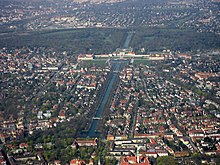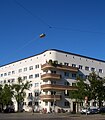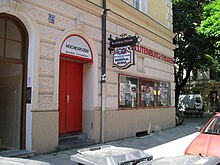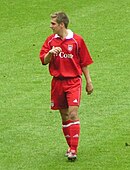Neuhausen-Nymphenburg
|
Neuhausen-Nymphenburg
State capital Munich
Coordinates: 48 ° 9 ′ 25 ″ N , 11 ° 31 ′ 0 ″ E
|
|
|---|---|
| Area : | 12.91 km² |
| Residents : | 100,233 (May 31, 2020) |
| Population density : | 7,761 inhabitants / km² |
| Postcodes : | 80634, 80636, 80637, 80638, 80639 |
| Area code : | 089 |
|
Location of the city district 9 Neuhausen-Nymphenburg in Munich
|
|
Neuhausen-Nymphenburg is the city district 9 of the Bavarian capital Munich . In 1992 Neuhausen and Nymphenburg merged to form today's city district.
location
District 9 stretches from Marsfeld on the outskirts of the city to the Nymphenburg Palace Park in the west and extends in its north-south extent from the Olympiapark via the villa colony of Gern to the railway tracks at Hauptbahnhof-Pasing.
Neighboring districts are Moosach in the north, Milbertshofen-Am Hart in the northeast, Schwabing-West and Maxvorstadt in the east, the Schwanthalerhöhe in the southeast, Laim in the south and Pasing-Obermenzing in the west.
History and description

A characteristic feature of this district is its potpourri of different urban planning elements.
The ten palaces on the roundabout of the palace, symmetrically divided into two groups of five, built between 1728 and 1758 for senior court servants and originally planned as the starting point for a "Carlstadt" (based on the model of the city of Karlsruhe), were used as the preliminary stage of a villa district. Old paintings show a lively street life on the paths within this development with the city wall-like border (e.g. Canaletto, Nymphenburg from the city side ). In Nymphenburg, especially from the end of the 19th century, a representative residential area was built around the access avenues to the palace complex, in which numerous examples of Wilhelminian architecture have been preserved, such as the villa colonies Neuwittelsbach and Gern .
The first mention is in 1170 as Niwenhusen , eponymous of the estate of Rudolfus de Niwenhusen. In Neuhausen, which was incorporated on January 1, 1890 and which was already a prosperous district in the late founding period, residential and commercial buildings in closed, dense block development characterize the cityscape. Along the Arnulfstrasse and its side streets, these are often housing cooperative buildings such as the experimental settlement of the Bavarian Post and Telegraph Association, some of which is listed, and the Neuhausen settlement . To the north of Rotkreuzplatz you can find more villas and town houses from the Wilhelminian era .
In the south along the tracks, there were large-scale commercial, industrial and railway uses, which have been used since the 1990s and a. as a result of the privatization of the railway systems were largely redeveloped in terms of urban planning. Rotkreuzplatz is the focal point and urban center of the district . Much well-preserved building stock from the founding and inter-war period with the rich offer of green spaces give Neuhausen a high quality of living. While the old building quarters around Nymphenburger Strasse have always been home to the upper middle class, the sometimes more modest turn-of-the-century buildings around Schulstrasse and Donnersbergerstrasse offer living space for a wide variety of population groups.
On January 1, 1899, the previously independent municipality of Nymphenburg was incorporated into the city of Munich.
The district is named after the Nymphenburg Palace , the former summer residence of the Bavarian electors and kings. Today the palace, together with the Nymphenburg Palace Park, is one of the most popular sights in Munich.
Right next to the castle is the 1747 of Elector Max III. Joseph founded Porzellanmanufaktur Nymphenburg , the Marstallmuseum Nymphenburg and the Museum Mensch und Natur . The botanical garden also borders the castle park ; Opposite its entrance is the Bavarian State Office for Weights and Measures . The Hirschgarten , the Grünwald Park and the Olympic Park bordering the district complement the rich offer of green and recreational areas. At the same time, however, the district is also burdened with a high volume of traffic due to the connection of the A 8 motorway to the urban area and a section of the Middle Ring . Since the urban subdivision that came into effect on May 1, 1996, when parts of Neuhausen and Nymphenburg, which previously belonged to the old tenth district, were reintegrated, Neuhausen-Nymphenburg has around 96,000 inhabitants, after Ramersdorf-Perlach, the second highest population in the Munich districts. In the north of Neuhausen, between Gern and Moosach, is the district of Nederling , in the northeast of the district of Ebenau .
The Volksgarten Nymphenburg was located on Romanplatz from 1890 to 1916 , at that time the largest amusement park in Germany.
In addition to the trade and service sector, most of the jobs in the district are in the public sector. In addition to the Deutsche Bahn branch , the Bundeswehr Administration Center, the Bavarian State Criminal Police Office and numerous hospitals such as the Red Cross Hospital , the German Heart Center , the Barmherzige Brüder Hospital and the Third Order, there are also large social institutions in the district. In 1929, the oldest city youth hostel in Germany was built at Wendl-Dietrich-Strasse 20, the extension of which, planned for 2014, is to open up to the adjacent Winthirplatz with large, curved glazing. The Munich Criminal Justice Center will be built on Leonrodplatz by 2021 . 1300 people will work there.
The proportion of foreigners in Nymphenburg is low, in Neuhausen it is average. In terms of age distribution, Neuhausen is the younger of the two quarters.
gallery
- Impressions from Neuhausen-Nymphenburg
The nurses' tower of the Rotkreuz Hospital on Rotkreuzplatz in Neuhausen
Nymphenburg Canal in winter
Hubertus Fountain in Neuhausen-Nymphenburg
Fountain on Rotkreuzplatz in Neuhausen
Education and culture
- Outdoor heating hall , Rainer-Werner-Fassbinder-Platz 1
- Backstage cultural center , Reitknechtstr. 6th
- Blutenburg Theater , Blutenburgstrasse 35
- History workshop Neuhausen e. V., Neuhauser Trafo, Nymphenburger Strasse 171a
- Munich Adult Education Center, Neuhausen branch, Neuhauser Trafo, Nymphenburger Strasse 171a (opening: September 2009)
- Munich City Library , District Library , Neuhauser Trafo, Nymphenburger Straße 171a (opening: January 2010)
- Von Parish Costume Library, Kemnatenstrasse 50
- Nymphenburg schools , school center, Sadelerstraße 10
- Pathos Transport Theater , Dachauer Straße 110d
- Heavy riders (theater) , Dachauer Strasse 114
- Summer Tollwood Festival , Oberwiesenfeld
- Maxim (cinema) , Landshuter Allee 33
Architectural monuments
- List of architectural monuments in Munich-Neuhausen
- List of architectural monuments in Munich-Nymphenburg
statistics

(As of December 31, residents with main residence)
| year | Residents | including foreigners | Inhabitants per km² |
|---|---|---|---|
| 2000 | 81,968 | 17,923 (21.9%) | 6,345 |
| 2001 | 82,235 | 17,972 (21.9%) | 6,366 |
| 2002 | 81,947 | 17,795 (21.7%) | 6.343 |
| 2003 | 81,661 | 17,703 (21.7%) | 6.321 |
| 2004 | 81,921 | 18,041 (22.0%) | 6.343 |
| 2005 | 82,156 | 17,890 (21.8%) | 6,362 |
| 2006 | 84,604 | 18,016 (21.3%) | 6,563 |
| 2007 | 85.964 | 18,118 (21.1%) | 6,674 |
| 2008 | 87,043 | 18,836 (21.2%) | 6,730 |
| 2009 | 87,846 | 18,147 (20.7%) | 6,792 |
| 2010 | 89.286 | 18,464 (20.7%) | 6,905 |
| 2011 | 92.139 | 19,848 (21.5%) | 7.135 |
| 2012 | 94.257 | 21,126 (22.4%) | 7,299 |
| 2013 | 95.906 | 22,083 (23.0%) | 7,426 |
| 2014 | 97,521 | 23,309 (23.9%) | 7,551 |
| 2015 | 98,702 | 24,264 (24.6%) | 7,643 |
| 2016 | 99,538 | 24,878 (25.0%) | 7,707 |
| 2017 | 98,520 | 24,005 (24.4%) | 7,629 |
| 2018 | 98,814 | 23,980 (24.3%) | 7,651 |
| 2019 | 100.213 | 24,907 (24.9%) | 7,760 |
Source with further data
politics
The district committee of Neuhausen-Nymphenburg was last elected on March 15, 2020. The distribution of seats is as follows: GRÜNE 16, CSU 9, SPD 8, FDP 2, DaCG / ÖDP 2, LINKE 2, FW 1 and AfD 1. Of the 73,135 residents in Neuhausen-Nymphenburg who are entitled to vote, 38,644 have exercised their right to vote the turnout was 52.8% (2014: 45.0%).
Anna Hanusch (Greens) was elected chairwoman of the district committee for the second time after the 2020 local elections. Your deputies are Sabine Nasko (CSU) and Anna-Lena Mühlhäuser (SPD). In the previous legislative period, Anna Hanusch (GREEN) was elected for the first time as chair of the district committee. Her deputies were Sabine Nasko (CSU) and Oliver Belik (SPD).
The city district is currently represented in the Munich city council by Kathrin Abele (SPD), Christian Köning (SPD), Anna Hanusch (GREEN), Leo Agerer (CSU), Thomas Lechner (left) and Fritz Roth (FDP), and Kristina Frank is also represented (CSU) municipal officer of the state capital Munich and in the district day of Upper Bavaria the city district is represented by Susanne Wittmann (animal welfare party).
Personalities

- The writer Alfred Andersch (1914–1980) was born and raised in Neuhausen. In the story The Father of a Murderer , which is about his school days, he describes the director of the Wittelsbacher Gymnasium at the time .
- The porcelain painter Maximilian Joseph Auer (1805–1878) was born in Nymphenburg.
- Monsignor Fritz Betzwieser (1929–1993) was pastor of the parish Herz Jesu from 1965 to 1993 . Due to his strong commitment to animal welfare, as well as u. a. his personal friendship with the Dalai Lama , whom he had invited to Neuhausen in 1986, was known far beyond the boundaries of his parish.
- In the novel Der Kanal , the writer Manfred Bieler (1934–2002) , who lived here until his death, portrayed the society of Nymphenburg.
- The historian Karl Bosl (1908–1993) lived for many years on Donnersbergerstrasse .
- Benno Danner (1857-1917), whose widow Therese Danner (1861-1934) founded the Danner Foundation , was the owner of the "Zimmergörglsölde" at Winthirstraße 18, which his grandmother bought in 1855 from Nymphenburg pharmacist Anton Gulielmo (1805-1872).
- The architect of the Gewofag settlement in Neuhausen, Hans Döllgast (1891–1974), lived in the settlement on Winthirplatz .
- The history of National Socialism is also closely linked to Neuhausen. The toolmaker Anton Drexler (1884–1942), founder of the German Workers' Party , lived and worked here.
- The Bavarian actor Helmut Fischer (1926–1997), best known outside of Bavaria for his role as “ Monaco Franze - the eternal Stenz”, was born in Neuhausen.
- The table tennis functionary and player Rudi Gruber (1922–2002) was born in Neuhausen.
- Lorenz Hauser (1869–1918) was born on the Strohmaier-Hof at Winthirstraße 6. He made great fortune by selling land and went down in history as the lavish and legendary “millionaire builder of Munich-Neuhausen”.
- Max Haushofer (1811–1866), landscape painter and professor of landscape painting, lived in Neuhausen .
- Ellis Kaut (1920–2015), the inventor of the Pumuckl , lived in Nymphenburg.
- A memorial plaque in Wendl-Dietrich-Strasse near Rotkreuzplatz commemorates the place of residence of the sculptor Karl Knappe (1884–1970) .
- Philipp Lahm (* 1983) , who used to play for FC Bayern Munich , was born in Gern .
- Karl Albert von Lespilliez (1723–1796), court architect, was born in Nymphenburg
- Oskar von Miller (1855–1934), the founder of the Deutsches Museum , was buried in the old Neuhausen cemetery. His tombstone can be found next to the chapel in the form of a large floor slab.
- The winner of Germany's Next Top Model 2009, Sara Nuru (* 1989), grew up near Rotkreuzplatz and went to elementary school on Blutenburgstrasse.
- Carl Orff (1895–1982) lived in Neuhausen for a long time. This is evidenced by the monument on the house where he was born (Maillingerstraße, house number 30).
- The journalist Ponkie (* 1926) lives in Neuhausen.
- Lilo Ramdohr (1913–2013) lived under the name Lilo Berndl from 1941 to mid-1944 at Prinzenstrasse 30, where in May 1942 Alexander Schmorell also hid boxes with White Rose leaflets .
- On the Nymphenburger cemetery is Eugen Roth buried (1895-1976), who lived for decades in Nymphenburg.
- The expressionist painter Ludwig Scharl (1929–2011) was born in Nymphenburg.
- The writer and anarchist Augustin Souchy (1892–1984) spent his old age near Rotkreuzplatz ; until the end he held readings and lectures in Neuhausen.
- Legend has it that Neuhausen was Christianized by the blessed Winthir in the 8th century . The street names Winthirstraße, Winthirplatz, Winthirkircherl , Winthirfriedhof , Winthirbrunnen and Winthir-Apotheke remind of him .
Festivals
- Every year in July, the Magdalenenfest takes place in the Hirschgarten .
- Every two years the water bird festival is celebrated at Rotkreuzplatz .
literature
- Helmuth Stahleder : From Allach to Zamilapark. Names and basic historical data on the history of Munich and its incorporated suburbs. City archive Munich, Buchendorfer Verlag, Munich 2001, ISBN 3-934036-46-5 .
Web links
- Neuhausen district - state capital Munich
- District Nymphenburg - state capital Munich
- Map with detailed delimitation of the city district
- City district and district committee 9 Neuhausen-Nymphenburg - City of Munich
- Cultural history trail 9: Neuhausen-Nymphenburg
- District committee 9 Neuhausen - Nymphenburg
Individual evidence
- ↑ Population in May 2020 (PDF). Statistical Office of the State Capital Munich. Retrieved August 03, 2020.
- ↑ [1]
- ↑ http://www.tz.de/muenchen/stadt/viertel-alter-muenchen-tz-1064110.html
- ↑ a b Wilhelm Volkert (Ed.): Handbook of the Bavarian offices, communities and courts 1799–1980 . CH Beck, Munich 1983, ISBN 3-406-09669-7 , p. 601 .
- ^ Archive district information . State capital Munich. Retrieved January 6, 2019.
- ↑ a b c Election of the district committee - District 9 - Neuhausen-Nymphenburg . State capital Munich. Retrieved March 20, 2020.
- ↑ [2] . Hello Munich. Retrieved June 23, 2020.
- ↑ [3] . Münchner Wochenanzeiger. Retrieved September 16, 2014.
- ↑ [4] . Hello Munich. Retrieved June 23, 2020.
- ↑ Susanne Wittmann. Retrieved February 25, 2020 .
- ↑ https://www.merkur.de/lokales/muenchen/fritz-betzwieser-1929-1993-pfarrer-tierfreund-91459.html
- ↑ muenchen.de
- ↑ Lilo Fürst-Ramdohr: Friendships in the White Rose . Geschichtswerkstatt Neuhausen Verlag, Munich 1995, ISBN 3-931231-00-3 , p. 79

























